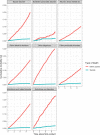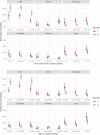Suicide mortality among psychiatric patients in Northeast Italy: a 10-year cohort study
- PMID: 35352672
- PMCID: PMC8967697
- DOI: 10.1017/S2045796021000792
Suicide mortality among psychiatric patients in Northeast Italy: a 10-year cohort study
Abstract
Aims: The present study investigated the relationship between suicide mortality and contact with a community mental health centre (CMHC) among the adult population in the Veneto Region (northeast Italy, population 4.9 million). Specifically, it estimated the effects of age, gender, time elapsed since the first contact with a CMHC, calendar year of diagnosis and diagnostic category on suicide mortality and modality.
Methods: The regional mortality archive was linked to electronic medical records for all residents aged 18-84 years who had been admitted to a CMHC in the Veneto Region in 2008. In total, 54 350 subjects diagnosed with a mental disorder were included in the cohort and followed up for a period of 10 years, ending in 2018. Years of life lost (YLL) were computed and suicide mortality was estimated as a mortality rate ratio (MRR).
Results: During the follow-up period, 4.4% of all registered deaths were from suicide, but, given the premature age of death (mean 52.2 years), suicide death accounted for 8.7% of YLL; this percentage was particularly high among patients with borderline personality disorder (27.2%), substance use disorder (12.1%) and bipolar disorder (11.5%) who also presented the highest suicide mortality rates. Suicide mortality rates were halved in female patients (MRR 0.45; 95% CI 0.37-0.55), highest in patients aged 45-54 years (MRR 1.56; 95% CI 1.09-2.23), and particularly elevated in the 2 months following first contact with CMHCs (MRR 10.4; 95% CI 5.30-20.3). A sensitivity analysis restricted to patients first diagnosed in 2008 confirmed the results. The most common modalities of suicide were hanging (47%), jumping (18%), poisoning (13%) and drowning (10%), whereas suicide from firearm was rare (4%). Gender, age at death and time since first contact with CMHCs influenced suicide modality.
Conclusions: Suicide prevention strategies must be promptly initiated after patients' first contact with CMHCs. Patients diagnosed with borderline personality disorder, substance use disorder and bipolar disorder may be at particularly high risk for suicide.
Keywords: Cohort study; mental disorder; record linkage study; suicide; suicide mortality.
Conflict of interest statement
None.
Figures


References
-
- Agerbo E, Gunnell D, Bonde JP, Mortensen PB and Nordentoft M (2007) Suicide and occupation: the impact of socio-economic, demographic and psychiatric differences. Psychological Medicine 37, 1131–1140. - PubMed
-
- Anderson KK, Fuhrer R and Malla AK (2010) The pathways to mental health care of first-episode psychosis patients: a systematic review. Psychological Medicine 40, 1585–1597. - PubMed
-
- Arango C, Díaz-Caneja CM, McGorry PD, Rapoport J, Sommer IE, Vorstman JA, McDaid D, Marín O, Serrano-Drozdowskyj E and Freedman R (2018) Preventive strategies for mental health. The Lancet Psychiatry 5, 591–604. - PubMed
-
- Arensman E, Larkin C, McCarthy J, Leitao S, Corcoran P, Williamson E, McAuliffe C, Perry IJ, Griffin E and Cassidy EM (2019) Psychosocial, psychiatric and work-related risk factors associated with suicide in Ireland: optimised methodological approach of a case-control psychological autopsy study. BMC Psychiatry 19, 1–11. - PMC - PubMed

